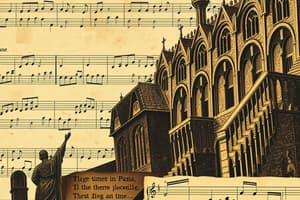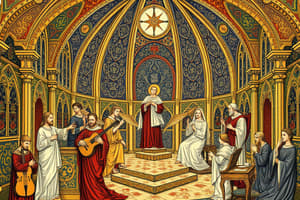Podcast
Questions and Answers
What was the primary role of the Church in music during the Middle Ages?
What was the primary role of the Church in music during the Middle Ages?
- To suppress all forms of music
- To solely focus on instrumental music
- To own and produce recorded music (correct)
- To promote secular music genres
Which of the following types of music did the Church promote?
Which of the following types of music did the Church promote?
- Instrumental symphonies
- Gregorian chant (correct)
- Lively folk songs
- Secular ballads
What was the common focus of the lyrics in secular music during the Middle Ages?
What was the common focus of the lyrics in secular music during the Middle Ages?
- Love, joy, and pain (correct)
- Historical battles and events
- Nature and the environment
- Religious devotion and worship
How did the Church generally respond to non-sacred music during the Middle Ages?
How did the Church generally respond to non-sacred music during the Middle Ages?
What characterizes the melodies typical of secular music during the Middle Ages?
What characterizes the melodies typical of secular music during the Middle Ages?
What is another name for Gregorian chant?
What is another name for Gregorian chant?
What primarily contributed to the formation of Gregorian chant?
What primarily contributed to the formation of Gregorian chant?
Which setting is Gregorian chant specifically associated with?
Which setting is Gregorian chant specifically associated with?
What characteristic defines the musical structure of Gregorian chant?
What characteristic defines the musical structure of Gregorian chant?
Who primarily performed Gregorian chants?
Who primarily performed Gregorian chants?
Flashcards are hidden until you start studying
Study Notes
Music in the Middle Ages
- The Church dominated music ownership and production during the Middle Ages.
- Manuscript music was primarily composed by church clerics.
- Sacred music genres promoted by the Church included plainsong, Gregorian chant, and liturgical songs.
- The Church sought to suppress non-sacred music forms to maintain spiritual focus.
Secular Music
- Despite Church suppression, secular music thrived in the Middle Ages.
- Secular music featured lively monophonic melodies.
- Common themes in secular music included love, joy, and pain, reflecting human experiences.
Gregorian Chant Overview
- Gregorian chant is a central form of early medieval music, characterized as a monophonic vocal line.
- The name derives from Pope Gregory I, who is traditionally credited with organizing the chant repertoire in the 6th century.
Historical Context
- Different musical traditions existed across various European regions, particularly Gallican and Roman chants.
- The blending of these distinct chants was crucial to standardizing Catholic liturgical music.
Characteristics
- Also referred to as plainchant or plainsong, emphasizing its single melodic line without accompaniment.
- Primarily performed by monks in monastic settings, underscoring its religious significance.
Importance
- Served as a foundational element of Western music, influencing the development of later musical forms and notation.
- Reflects the spirituality and liturgical practices of the Catholic Church during the medieval era.
Studying That Suits You
Use AI to generate personalized quizzes and flashcards to suit your learning preferences.




